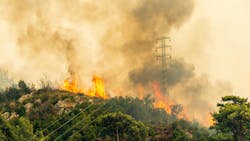PG&E Energizes More Than 800 Miles of Underground Powerlines in High Wildfire-Risk Areas
Pacific Gas and Electric Company (PG&E) has constructed and energized more than 800 miles of underground powerlines after launching its wildfire safety undergrounding effort in 2021.
PG&E completed more than 360 miles of undergrounding in 2023. Customers in 27 counties are served by the buried lines to permanently reduce 98% of wildfire risk in these locations and improve reliability.
PG&E has completed more than 187 miles of work as part of its target of undergrounding 250 miles in 2024. Customers in the Spring Valley area (Lake County), Vacaville (Solano County) and the Pine Grove area (Amador County) are served by underground powerlines.
PG&E plans to complete an additional 330 miles of undergrounding in 2025 and another 440 miles in 2026 in the highest wildfire-risk portions of the company's service area. It will bring PG&E to a total of more than 1,600 total miles of undergrounding completed across 30 counties in Northern and Central California by the end of 2026.
PG&E uses machine-learning-based risk modeling to find out the highest-risk lines for undergrounding. This includes a fire-propagation technology, developed by Technosylva and also used by CAL FIRE, the U.S. Forest Service and other utilities.
PG&E will analyze additional projects in high fire-risk areas for undergrounding workplans in 2027 and beyond. While priority is given to the highest-risk circuits, details on long-term plans will be shared in PG&E's 10-Year Electrical Undergrounding Plan to be filed in 2025.
PG&E's layers of protection, including undergrounding, have reduced wildfire risk across its service area with no catastrophic fires from company equipment in 2023 and a reduced wildfire risk since 2018.
Additional layers of wildfire protection include:
- Strengthening the electric system with strong poles and covered powerlines in and near high fire-risk areas.
- Deploying Enhanced Powerline Safety Settings (EPSS) to decrease ignitions and provide wildfire protection to 44,000 line miles and all 1.8 million customers living in high fire-risk areas. In 2023, there was a 72% reduction in CPUC-reportable ignitions on EPSS-enabled lines in High Fire-Threat Districts (compared to the 2018-2020 average).
- Continuing to reduce the impact of Public Safety Power Shutoffs, which remains a top focus for the company.
- Managing trees and other vegetation located near powerlines that could cause a power outage and/or ignition.
- Leveraging a network of over 1,500 weather stations, or one station every 18 line-miles, to better predict and respond to severe weather threats.
- Using 600 high-definition cameras, which provide the ability to see more than 90% of the high fire-risk areas.
- Investing in advanced tools and technologies like artificial intelligence and drones helping automate fire detection and response.
